Museum of the Bible
The Museum of the Bible is a museum in Washington D.C. which documents the narrative, history, and impact of the Bible. It opened on November 17, 2017,[2] and has 1,150 items in its permanent collection and 2,000 items on loan from other institutions and collections.[3]
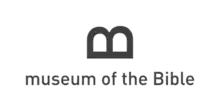 | |
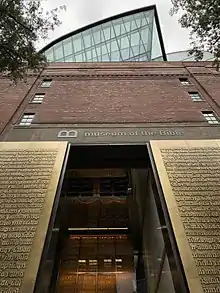 Museum of the Bible, November 4, 2017 before opening | |
 Location within Washington, D.C. | |
| Established | November 17, 2017 |
|---|---|
| Location | 400 4th St SW Washington, D.C., United States[1] |
| Coordinates | 38°53′05″N 77°01′01″W |
| Type | History museum |
| Collection size | 40,000+ |
| Founder | Steve Green |
| CEO | Harry Hargrave |
| Architect | David Greenbaum |
| Public transit access | |
| Website | www |
The museum is nonsectarian and non-political, and it does not proselytize.[4][5] Former museum president Cary Summers said that the goal is to "reacquaint the world with the book that helped make it, and let the visitor come to their own conclusions. ... We don't exist to tell people what to believe about it".[5] Despite the museum's nonsectarian stance, members of the board of directors are required to sign a "faith statement".[6]
In the year before its launch, the museum fielded questions about the acquisition of its collection, including a federal case over smuggled Iraqi antiquities and thousands of clay artifacts.[7] The museum's dedication ceremony received an official pontifical blessing from Pope Francis, and people in attendance included Cardinal Donald Wuerl, musician CeCe Winans, Senate Chaplain Barry Black, Washington, D.C. Mayor Muriel Bowser, and Israeli Ambassador Ron Dermer.[4]
The Museum of the Bible features dining, including a restaurant called Manna that serves kosher food.[8]
History
The museum was established as a nonprofit in 2010.[9] The museum's building location and design were announced in 2012 when the Green family purchased the 1923 Terminal Refrigerating and Warehousing Co. building,[10] two blocks from the National Mall that used to be the Washington Design Center in Washington, D.C.[11][12] The primary donors to the museum at launch were Hobby Lobby and its owners, the Green family and the National Christian Foundation.[13]
The estimated $400 million project updated the historically protected structure as well as adding two additional floors and a rooftop café and garden. The building's 1923 original red brick, architecture and ornamentation was restored, with new bricks imported from Denmark. The primary building was awarded historical status by the District's Historic Preservation Review Board.[14][15][16][17] The glass-enclosed rooftop provides views of the United States Capitol, the Washington Monument and several Smithsonian museums. The construction efforts were led by Clark Construction. The architectural design team was led by SmithGroup.[17]
Exhibits
The exhibits intend to offer a scholarly perspective on the impact of the Bible in history.[18] Bible scholar David Trobisch, former director of the museum's collections, was hired to advise on new acquisitions, identify the storylines for the museum's exhibits, and supervise a team of thirty scholars and curators.[19][20] Indiana Wesleyan University professor Jerry Pattengale serves as Executive Director of Education Initiatives.[21] The Museum has an external board of advisors, and works with Jewish, Protestant, Catholic, and other religious and secular institutions.[5]
Each of the six floors in the museum contain a different exhibit which emphasizes different aspects of the Bible's history or impact. This includes three permanent exhibit floors, each measuring 55,000 square feet (5,100 m2).[17] The first floor combines ancient artifacts with modern technology meant to immerse the participant in the Bible. The front entrance on 4th Street SW features 40-foot (12 meter) tall, 2.5 tonnes (2,500 kg) bronze front doors with stained glass art containing a relief depicting the creation account in Genesis.[17][22] There is also a grand lobby with a 200-foot (60 meter) LED ceiling allowing for changing visual effects and messages.[17]
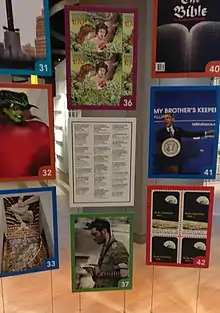
The second floor focuses on the Bible's impact on world culture, in areas like science, justice, and freedom. Another section is dedicated to the Bible's impact in American history.
The third floor presents the general narrative of the Bible from Abraham through the creation of Israel to the ministry of Jesus and the early church. This floor also contains a large Jewish Bible section.
The fourth floor presents biblical history and archaeology. Trobisch stated that the museum "will not whitewash conflicts in Christian history but will explain the arguments that were made at the time".
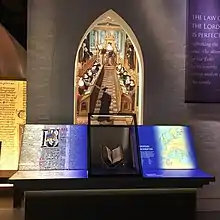
The fifth level contains a performing arts theater with a 500-person amphitheater. The museum plans to sponsor scholarly lectures as well as multimedia performances relating to the Bible. The fifth floor also contains separate exhibit space for displays presented by the Israel Antiquities Authority.
The sixth floor consists of a rooftop viewing areas overlooking the National Mall and U.S. Capitol, stained glass exhibits, and a ballroom that seats 1,000 guests.[17][22] The museum's artifact research facility and reference library is located in a one-story addition to the roof of a neighboring office complex.[17]
Several museum partners are responsible for the design and layout of the various exhibits. The PRD Group was responsible for the history of the Bible floor. PRD Group has previously collaborated on exhibits at Smithsonian National Museum of American History and National Museum of Natural History. BRC Imagination Arts is developing the narrative of the Bible floor. Jonathan Martin Creative recreated a Nazareth village from the first century. C&G Partners led the design of the impact of the Bible floor. Previous work by C&G Partners includes the United States Holocaust Memorial Museum and the Abraham Lincoln Presidential Library and Museum.[17]
The museum contains more than 40,000 objects and artifacts,[23] ranging from the time of Abraham through the New Testament period. Planned artifacts include biblical papyri, Torah scrolls, rare printed Bibles, Jewish artifacts and contemporary treasures of Christian and Jewish culture.[24] The museum has made arrangements to exhibit significant archaeological artifacts owned by collaborating institutions and private collectors such as the Israel Antiquities Authority.[25] Steve Green has donated other ancient artifacts from his personal collection.[26] Additional initial exhibits include remains from Julia Ward Howe's original manuscript for the famous song "The Battle Hymn of the Republic" as well as a replica of the Liberty Bell upon which is engraved the Bible verse from Leviticus "Proclaim liberty throughout all the land unto all the inhabitants thereof".[27][28]
The roof of the museum features a Biblical garden.[18][29]
Food services
"Equinox" owners and "The Jewish Table" authors Todd and Ellen Gray operate a 165-seat, Mediterranean-inspired, fine-dining restaurant inside the Museum.[30] The Grays also provide catering for events at the museum. The Museum also contains a more casual lunch and coffee shop, where some of the food offerings are certified as kosher.[29][31][32]
Opening
On Thursday, November 16, 2017, museum officials held a private opening gala and reception for the facility at the Trump International Hotel Washington D.C. in the Old Post Office Building.[33] A single seat at the fundraising event cost $2,500, while tables cost from $25,000 to $50,000.[33] However, a number of museum employees and academic consultants refused to enter, citing the problem of having the event in a hotel affiliated with the president of the United States, Donald Trump.[33]
The museum opened on Friday, November 17, in a private ceremony in the museum's theater that dedicated the facility.[34] Pope Francis sent an official pontifical blessing for the museum's dedication.[4] According to a message from the Vatican's Cardinal Secretary of State, Pietro Parolin, who had visited Washington earlier in the week, the Pope stated that "He is confident that those who revere the sacred scriptures as the word of God will here find nourishment for their faith, while many others will be introduced to a fascinating and vital chapter in the spiritual history of the human family".[4]
The dedication ceremony, which nearly 500 people attended, began with the hymn "Amazing Grace" that Gospel singer CeCe Winans sang.[34] After reading Parolin's message, Cardinal Donald Wuerl, the Archbishop of Washington, offered the ceremony's opening prayer, which was followed by prayers and remarks from Chaplain of the United States Senate Barry Black, Chief of Chaplains of the United States Navy Admiral Margaret Kibben and Mayor of the District of Columbia Muriel Bowser.[4][34]
Ron Dermer, the Israeli Ambassador to the United States, celebrated the museum as a signifier of the Jewish claim to Jerusalem.[8] The Bible nurtured Jews through 2,000 years of exile until they were able to "rebuild the original DC — David's Capital," Dermer said at the dedication ceremony.[8] Yariv Levin, the Israeli tourism minister, read a letter from the Israeli Prime Minister Benjamin Netanyahu, who had sent "warm greetings from Jerusalem, the eternal and undivided capital of Israel".[8][34] Mor Dionysius John Kawak, archbishop of the Syriac Orthodox Church and other representatives of that Oriental Orthodox denomination were in attendance at an official dinner for the museum's opening.[35]
When the museum opened to the public on Saturday, November 18, the lines outside were short.[36] Some exhibits bustled with visitors, while others were nearly empty and the museum was far from capacity.[36]
Admission fees
When it opened to the public, the museum offered free admission with a suggested donation of $15.00.[37] However, on December 10, 2018, the museum began to charge admission fees of up to $24.99 per adult.[38]
Reception
Historians Kelly Gannon and Kimberly Wagner evaluated the Museum as a, "testament to the power of evangelical impulses tempered by a desire to legitimate the Bible as a centerpiece of conversation in American life." They conclude:
- There is much that makes this museum great. The design of the space is stunning and well thought out. Likewise, the impressiveness of the technology cannot be overstated ... Finally, the collection is notable for its size and breadth ... Yet, despite all of this, MOTB remains a confusing amalgamation of historical and biblical scholarship, evangelical influence, and the desire to be a modern attraction. While MOTB's intent is not necessarily proselytization, its aims and purpose are often obscured by unspoken ideological and theological battles raging just under the surface. With all of the forces pulling at Museum of the Bible, it loses its sense of identity and risks becoming an evangelical tourist attraction, though it has the potential to be much more.[39]
At first the museum came under criticism for the original wording of its mission, which described an evangelistic purpose of the museum, namely, to "inspire confidence in the absolute authority and reliability of the Bible."[10][40] A later statement shifted away from that language. A revised 2013 mission statement reads, "We exist to invite all people to engage with the Bible. We invite Biblical exploration through museum exhibits and scholarly pursuits."[40]
Lawrence Schiffman, an authority on the Dead Sea Scrolls and professor of Hebrew and Jewish studies at New York University stated, with respect to the Museum of the Bible:[41]
The overarching narrative is the impact of the Bible ... its own internal history of how it came together, spread and was passed on. It exudes one of the best things about art culture in this country. Protestant, Catholic, Jewish, Ethiopic, Orthodox — all of them are here. There's a message of shared culture and respect that the museum exudes. Everyone who comes here is going to go out with that message.[41]
In contrast to these comments, Biblical scholars Joel Baden of Yale Divinity School and Candida Moss of University of Birmingham, who wrote the book Bible Nation: The United States of Hobby Lobby,[42] expressed concerns about the museum's mission, saying, "They have misled the public at large by promoting a curriculum and a museum that tell only the story that the Greens want to tell, without acknowledging that scholars and experts have spent decades, indeed centuries, laboring to provide very different accounts of the Bible and its history."[43]
After spending many hours while writing the book with museum founder Steve Green and president Cary Summers, they concluded:
It's not really a museum of the Bible, it's a museum of American Protestantism. Their whole purpose is to show this country as a Christian country governed by Christian morality. (Moss)[44]
Their three-minute promo is fascinating demonstration of this problem. At least half of it is a reenactment of American history which has no bearing on the Bible—the signing of the Declaration of Independence, for example, or the Revolutionary War. The worry is that the museum portrays a story of the Bible that culminates in Protestantism and America. (Baden)[44]
John Fea, associate professor of American history at Messiah College, and chair of the history department, said, "It's hard to see this as anything other than an attempt to try to bring Christian values in the Bible's teachings as understood by evangelical protestants, like the Greens, into the center of American political life and American cultural life."[45]
However, the Catholic theologian Thomas L. McDonald, writing in the National Catholic Register praised the abundance of material dedicated to the history of the Bible with respect to Roman Catholicism:[41]
In 2012, the museum brought its traveling Verbum Domini exhibit to the Vatican, which helped forge relationships with the Vatican Museums and Vatican Library. A similar exhibit was mounted in Philadelphia during the visit of Pope Francis, continuing the museum's process of courting Catholic leaders and press. The result is a permanent space on the first floor of the museum for rotating exhibits from the Vatican, including the giant illuminated Urbino Bible (15th century) and a number of reproduction frescoes illustrating Church councils. New items will be brought from Rome every six months. In addition, one of the special exhibits for the opening is a series of Stations of the Cross sculptures. Catholicism permeates the art and exhibits. A section of paintings and sculpture shows how artists depicted the Virgin Mary throughout history. Dorothy Day and St. Josephine Bakhita highlight an exhibit on social justice. There's the prayer book of Emperor Charles V, who condemned Luther as an outlaw, and various versions of the Vulgate and Douay-Rheims Bibles, among other Catholic versions. Pre-Reformation books and illuminated manuscripts, displays of Catholic architecture and art, the role of monks and nuns, and discussions of Catholic saints and scholars are all in the mix.[41]
A blog article in The Economist criticized the Museum of the Bible for focusing on Protestant, Jewish and Roman Catholic views, but ignoring the views of Orthodox Christianity and not mentioning the impact of the Bible on Islam or taking into account the opinions of scholars who do not consider that the Bible contains a coherent story.[46]
Hobby Lobby smuggling scandal
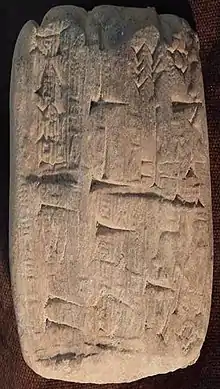
In early July 2017, US federal prosecutors filed a civil complaint in the Eastern District of New York under the case name United States of America v. Approximately Four Hundred Fifty Ancient Cuneiform Tablets and Approximately Three Thousand Ancient Clay Bullae.[47] On July 5, 2017, Hobby Lobby consented to a settlement requiring forfeiture of the artifacts and payment of a fine of $3 million and the return of over 5500 artifacts.[48][49][50] The U.S. Immigration and Customs Enforcement seized thousands of clay tablets and bullas from Hobby Lobby.[51] The artifacts in question had likely been stolen from Iraq. Hobby Lobby was found to have used couriers that had willfully used methods to conceal the provenance of the allegedly stolen items. The museum released a statement that these artifacts were never owned by the Museum of the Bible and were never intended to be part of their collection. In 2018, the items were returned to Iraq, and the company paid a $3 million fine.[52]
Scott Thumma, a dean and professor of sociology of religion at Hartford Seminary, defended Hobby Lobby during the smuggling controversy. Thuma stated: "Many of the collections of our great national museums and universities are full of the very objects that Hobby Lobby is being fined for smuggling and are seldom required to return or pay compensation."[53]
The Museum of the Bible's board chairman, Steve Green, who is also president of the Hobby Lobby stores, announced the museum will be returning over eleven thousand artifacts to Egypt and Iraq. The collection includes thousands of papyrus scraps and ancient clay pieces. Green admitted, "I knew little about the world of collecting ... The criticism of the museum resulting from my mistakes was justified." Manchester University papyrologist Roberta Mazza stated that the Green family “poured millions on the legal and illegal antiquities market without having a clue about the history, the material features, cultural value, fragilities, and problems of the objects.”[54]
This return includes the "Gilgamesh Dream Tablet," containing part of the Epic of Gilgamesh, was discovered in Iraq in 1853,[55] sold by the Jordanian Antiquities Association to an antiquities dealer in 2003,[56] and sold again by an auction house to Hobby Lobby in 2014 for $1.6 million. The auction house lied about how the artifact had entered the market, claiming it had been on the market in the United States for decades. In September 2019, federal authorities seized the tablet, and in May 2020, a civil complaint was filed to forfeit it.[57][58]
Dead Sea Scrolls forgeries
Founder Steve Green donated Dead Sea Scrolls parchment fragments to the museum collection for its opening. When the museum catalog was released to the public, however, several outside experts expressed concern that the museum had not adequately accounted for the fragments' provenance. Arstein Justnes, a professor of biblical studies at the University of Agder in Norway, declared they were outright forgeries. The museum subsequently enlisted the German Federal Institute for Materials Research and Testing (Bundesanstalt für Materialforschung und Prüfung) to analyze the scrolls. The museum kept the fragments prominently on display for its official opening, while testing was still incomplete. The text of display stated that "scholars continue to debate the authenticity of this fragment". In 2018 the museum announced that expert examination had led it to conclude that five of the sixteen fragments of the Dead Sea Scrolls were forgeries and that the museum had removed them from display. According to the German researchers, those five showed "characteristics inconsistent with ancient origin".[59] In March 2020, the museum confirmed all sixteen fragments were forgeries.[60][61]
Board and leadership
- Steve Green – president of Hobby Lobby[62]
- Allon Lefever – entrepreneur, former business professor at Eastern Mennonite University
- Anne Beiler – founder of Auntie Anne's Pretzels
- Carlos Campo – president of Ashland University
- Rick Warren – founder and pastor of Saddleback Church
- Robert E. Cooley – vice chairman of the board; president emeritus of Gordon-Conwell Theological Seminary
- Gregory Baylor – senior counsel with Alliance Defending Freedom
- Harry Lee Crisp III – director and owner of Pepsi MidAmerica and Crisp Container Corporation
- James Moore Jr. - former president and chief operating officer of Coca-Cola Bottling Co. Consolidated
- Mary Banks – president of WOW Consulting Group
- Bob Hoskins (philanthropist) – secretary of the board; founder of OneHope
Gallery
- Museum of the Bible
 Detail of museum plaque
Detail of museum plaque Front entrance
Front entrance Street level view
Street level view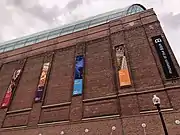 Exterior wall
Exterior wall
References
- "Museum of the Bible". www.museumofthebible.org. Archived from the original on 2017-10-18.
- "Museum – Main site". Museum of the Bible. Archived from the original on 12 May 2017. Retrieved 25 May 2017.
- "Collections". Archived from the original on 2017-12-31.
- White, Christopher (18 November 2017). "Pope Francis sends official blessings for Museum of the Bible opening". Crux. Archived from the original on 18 November 2017. Retrieved 23 April 2018.
- "The real Museum of the Bible". The Times of Israel. Archived from the original on 2016-05-04. Retrieved 2016-05-03.
- Stracqualursi, Veronica (November 18, 2017). "Museum of the Bible faces revelations, controversy as it opens". ABC News. Archived from the original on 2017-11-18. Retrieved 2017-11-18.
- "Questions swirl around Museum of the Bible before grand opening". NBC News. Archived from the original on 2017-11-17. Retrieved 2017-11-17.
- Kampeas, Ron (17 November 2017). "Judaism is the star at a Bible museum built by Hobby Lobby". The Times of Israel. Archived from the original on 18 November 2017. Retrieved 23 April 2018.
- "Journey to the Grand Opening: A Timeline of Museum of the Bible". Washington, D.C.: Museum of the Bible. Archived from the original on 1 December 2018. Retrieved 1 December 2018.
- Kennicott, Philip (November 15, 2017). "Perspective | The new Bible museum tells a clear, powerful story. And it could change the museum business". Washington Post. Archived from the original on 2017-11-16. Retrieved 2017-11-16.
- Banks, Adelle M. (July 10, 2012). "Bible museum planned for Washington, D.C." Washington Post. Archived from the original on 27 February 2015. Retrieved 28 May 2015.
- Sernovitz, Daniel (July 20, 2012). "Museum makes a divine acquisition". Washington Business Journal. Archived from the original on 27 February 2015. Retrieved 28 May 2015.
- McGlone, Peggy (2 November 2017). "Will money from conservative Christians sway Bible museum's professed mission?". Museums. The Washington Post. Archived from the original on 1 December 2018. Retrieved 1 December 2018.
- DPA (13 February 2015). "Private Bible museum to be built in heart of Washington, D.C." Haaretz. Archived from the original on 27 May 2015. Retrieved 28 May 2015.
- Cooper, Rebecca (12 February 2015). "Here's the Museum of the Bible's $400M plan for the former Washington Design Center". Washington Business Journal. Archived from the original on 15 February 2015. Retrieved 28 May 2015.
- Parker, Loanne (28 March 2014). "Which Museums Show Real Promise?". The Washington Post. Archived from the original on 16 April 2015. Retrieved 28 May 2015.
- "Construction begins on 430,000-square-foot Museum of the Bible". University of Leicester. 13 February 2015. Archived from the original on 2016-11-22. Retrieved 21 November 2016.
- O'Connell, Jonathan (12 February 2015). "Even non-believers may want to visit the $400 million Museum of the Bible". The Washington Post. Archived from the original on 9 May 2015. Retrieved 28 May 2015.
- "Green family Bible museum closer to opening". Baptist Press. 7 March 2014. Archived from the original on 1 July 2015. Retrieved 29 May 2015.
- Boorstein, Michelle (12 September 2014). "Hobby Lobby's Steve Green has big plans for his Bible museum in Washington". The Washington Post. Archived from the original on 10 May 2015. Retrieved 29 May 2015.
- "Jerry Pattengale, Ph. D." Museum of the Bible. Archived from the original on 19 April 2017. Retrieved 25 May 2017.
- Porter, Kevin (21 Aug 2016). "Behind-the-scenes tour of Museum of the Bible: 5,000 lb Genesis bronze door, electronic Biblical art ceiling". Christian Post. Archived from the original on 2016-12-15. Retrieved 25 Oct 2016.
- Taylor, Kate (23 October 2018). "The $500 million Museum of the Bible founded by Hobby Lobby's controversial president has admitted it displayed fake Dead Sea Scrolls. Here's what it's like to visit". Business Insider. Insider Inc. Retrieved 1 December 2018.
The Museum of the Bible hosts 40,000 biblical and religious artifacts, such as this Gospel Book from 17th-century Turkey.
- "Museum of the Bible holds "topping out" celebration for D.C. building". NRB.com. 22 September 2016. Archived from the original on November 22, 2016. Retrieved 21 Nov 2016.
- Charney, Noah (4 September 2015). "Critics call it evangelical propaganda. Can the Museum of the Bible convert them?". The Washington Post. Archived from the original on 23 September 2015. Retrieved 27 September 2015.
- Pruitt, Sarah (11 Oct 2016). "Secrets of the Dead Sea Scrolls come to light". history.com. Archived from the original on 2016-11-16. Retrieved 21 November 2016.
- Porter, Kevin (7 Nov 2016). "Museum of the Bible to display historic 'Battle Hymn of the Republic'". The Christian Post. Archived from the original on 2016-12-12. Retrieved 21 November 2016.
- Mitchell, Andre (19 Aug 2016). "Bible museum in U.S. capital gets Liberty Bell replica as its first display". Christianity Today. Archived from the original on 2016-12-12. Retrieved 21 November 2016.
- Sheir, Rebecca. "D.C. Bible Museum Will Be Immersive Experience, Organizers Say". NPR. Archived from the original on 25 February 2015. Retrieved 25 February 2015.
- Lefrak, Mikaela (7 August 2018). "Is this biblical food the next foodie fad? This chef thinks so". Washington Post. Retrieved 8 August 2018.
- "Museum of the Bible Gives Preview in NYC". The Jewish Voice. 9 December 2015. Retrieved 13 December 2015.
- Sidman, Jessica (3 Nov 2016). "Equinox owners will open an Israeli street food cafe in the Museum of the Bible". Washingtonian. Archived from the original on 2016-11-22. Retrieved 21 Nov 2016.
- Boorstein, Michelle (15 November 2017). "D.C.'s new Bible museum says it wants to avoid politics. But its opening gala is at the Trump hotel". Acts of Faith. The Washington Post. Archived from the original on 1 December 2018. Retrieved 30 November 2018.
- Boorstein, Michelle (17 November 2017). "D.C. officially gets a new major Bible museum — and prayers at its dedication for evangelization". Acts of Faith. The Washington Post. Archived from the original on 20 November 2017. Retrieved 20 November 2017.
- Saliba, Dayroyo (16 November 2017). "Grand Opening of the Museum of the Bible". Syriac Orthodox Church of Antioch. Archived from the original on 2 December 2018. Retrieved 23 April 2018.
- McGlone, Peggy; Contrera, Jessica; McCarthy, Ellen; Zauzmer, Julie (18 November 2017). "'I had to be there': The Museum of the Bible opens in the nation's capital". Acts of Faith. The Washington Post. Archived from the original on 20 November 2017. Retrieved 3 January 2019.
- McGlone, Peggy (11 August 2017). "Museum of the Bible to offer free admission when it opens in November". Arts and Entertainment. The Washington Post. Archived from the original on 1 September 2018. Retrieved 3 January 2019.
The Museum of the Bible will offer free admission when it opens its 430,000 square-foot facility on Nov. 17, officials announced Friday. The nonprofit museum will suggest a donation of $15 for entry but it will not require guests to pay anything.
“Our mission is to invite all people to engage with the Bible, and with a suggested donation we believe more people will come,” Vice President of Marketing Steven Bickley said.
Operating in a city where many museums have free admission, officials decided a suggested donation was the best policy. “Our goal is to be self-sustaining, so you have a trade-off,” Bickley said. “The rate will go down but we will have a higher volume.” - "Admission Policy FAQ". Museum of the Bible. Archived from the original on 17 December 2018. Retrieved 3 January 2019.
What has changed in the 13 months since your opening that would indicate your free admission policy is not sustainable?
While some guests have shown their generosity by choosing to pay the suggested donation, analysis has shown that these donations alone will not ensure a financially sustainable, quality experience for future guests. - Kelly Gannon and Kimberly Wagner, "Museum of the Bible." Journal of American History (Dec. 2018) 105#3 pp 618–625, quoting page 625.
- Charney, Noah (4 September 2015). "Critics call it evangelical propaganda. Can the Museum of the Bible convert them?". The Washington Post. Archived from the original on 2017-02-22. Retrieved 20 December 2016.
- McDonald, Thomas L. (20 November 2017). "Museum of the Bible Highlights the Holy Book and Time-Honored Treasures". National Catholic Register. Retrieved 23 April 2018.
- Moss, Candida; Baden, Joel S. (October 15, 2017). "Just What Is the Museum of the Bible Trying to Do?". POLITICO Magazine. Archived from the original on 2017-11-18. Retrieved 2017-11-17.
- Moss, Candida R.; Baden, Joel S. (2017-09-22). Bible Nation: The United States of Hobby Lobby. Princeton University Press. ISBN 978-1-4008-8831-3. Archived from the original on 2017-11-20.
- Haber, Gordon (November 8, 2017). "Investigating the Hobby Lobby Family: An Interview with Candida Moss and Joel S. Baden". Religion & Politics. Archived from the original on 2017-11-18. Retrieved 2017-11-17.
- Block, Deborah (November 17, 2017). "Controversial Bible Museum to Open in Washington". VOA. Archived from the original on 2017-11-19. Retrieved 2017-11-17.
- "The Museum of the Bible opens in Washington, DC". The Economist. November 17, 2017. Archived from the original on 2017-11-17. Retrieved 2017-11-17.
- Green, Emma (2017-07-05). "Hobby Lobby Purchased Thousands of Ancient Artifacts Smuggled Out of Iraq".
- James, Mike (July 6, 2017). "Hobby Lobby fined $3M over 5,500 smuggled Iraqi artifacts". USA Today. Retrieved November 18, 2019.
- Feuer, Alan (2017-07-05). "Hobby Lobby Agrees to Forfeit 5,500 Artifacts Smuggled Out of Iraq". The New York Times. ISSN 0362-4331. Retrieved 2017-07-06.
- Siu, Diamond Naga. "Hobby Lobby agrees to $3 million fine, forfeiture of thousands of Iraqi relics". POLITICO.
- "ICE returns thousands of ancient artifacts seized from Hobby Lobby to Iraq". www.ice.gov. Retrieved 2018-05-03.
- McGlone, Peggy (2018), "Hobby Lobby's illicit artifacts are returned to their Iraqi homeland", Washington Post, retrieved August 17, 2018
- "Despite smuggled antiquities purchase, some say criticism of Bible museum is unfair". Religion News Service. Archived from the original on 2017-08-11. Retrieved 2017-08-10.
- Cascone, Sarah (30 March 2020). "Amid Scrutiny, the Museum of the Bible's Founder Will Return a Staggering 11,500 Artifacts of Dubious Origin to the Middle East". ArtNet News. Retrieved 18 April 2020.
- "Gilgamesh complaint". USA Department of Justice. 20 May 2020.
- Meier, Martin Gottlieb With Barry (2003-05-01). "AFTEREFFECTS: THE PLUNDER; Of 2,000 Treasures Stolen in Gulf War of 1991, Only 12 Have Been Recovered". The New York Times. ISSN 0362-4331. Retrieved 2020-05-19.
- Stelloh, Tim (18 May 2020). "Authorities announce forfeiture of ancient Gilgamesh tablet from Hobby Lobby's Museum of the Bible". NBC News. Retrieved 19 May 2020.
- "Civil action filed to forfeit rare cuneiform tablet from Hobby Lobby". www.ice.gov. Retrieved 2020-05-19.
- (1) Tov, Emanuel; Davis, Kipp; Duke, Robert R. (2016). Dead Sea Scrolls fragments in the Museum collection. ISBN 9789004321489. OCLC 964454595.
(2) Burke, Daniel (November 17, 2017). "Mystery at the new Bible museum: Are its Dead Sea Scrolls fake?". CNN. Archived from the original on 2017-11-17. Retrieved 2017-11-17.
(3) Greshko, Michael (November 17, 2017). "Forgeries May Hide in Museum of the Bible's Dead Sea Scrolls". Archived from the original on 2017-11-18. Retrieved 2017-11-18.
(4) "Museum of the Bible says five of its Dead Sea Scrolls fragments are forgeries". Guardian. October 22, 2018. Retrieved October 23, 2018.
(5) Editor, Daniel Burke, CNN Religion. "Bible Museum says five of its Dead Sea Scrolls are fake". CNN. Retrieved 2018-10-22.CS1 maint: extra text: authors list (link)
(6) Moss, Candida (2018-10-22). "Bible Museum's Dead Sea Scrolls Turn Out to Be Forgeries". The Daily Beast. Retrieved 2018-10-22. - "Exclusive: 'Dead Sea Scrolls' at the Museum of the Bible are all forgeries". History. 2020-03-13. Retrieved 2020-03-13.
- Ouellette, Jennifer (2020-03-23). "All 16 Dead Sea Scroll fragments in the Museum of the Bible are fakes". Ars Technica. Retrieved 2020-03-25.
- "Leadership". www.museumofthebible.org. Archived from the original on 2017-11-19. Retrieved 2017-11-18.
External links
| Wikimedia Commons has media related to Museum of the Bible. |
- Official website
- Bible museum replaces chief executive after one year, Washington Post
- United States Files Civil Action To Forfeit Thousands Of Ancient Iraqi Artifacts Imported By Hobby Lobby, the July 2017 United States government complaint
- Hobby Lobby to pay $3 million fine, forfeit ancient artifacts, CNN
- Iraqi Artifacts Once Bought by Hobby Lobby Will Return Home, The New York Times
- Hobby Lobby's Smuggled Artifacts Will Be Returned To Iraq, NPR
- Some of Hobby Lobby’s Smuggled Artifacts May Come From Lost Sumerian City, Smithsonian
- ‘It’s the First Domino’: After the Museum of the Bible Discovered Its Dead Sea Scrolls Are Fake, the Field Braces for More Revelations, ArtNet News